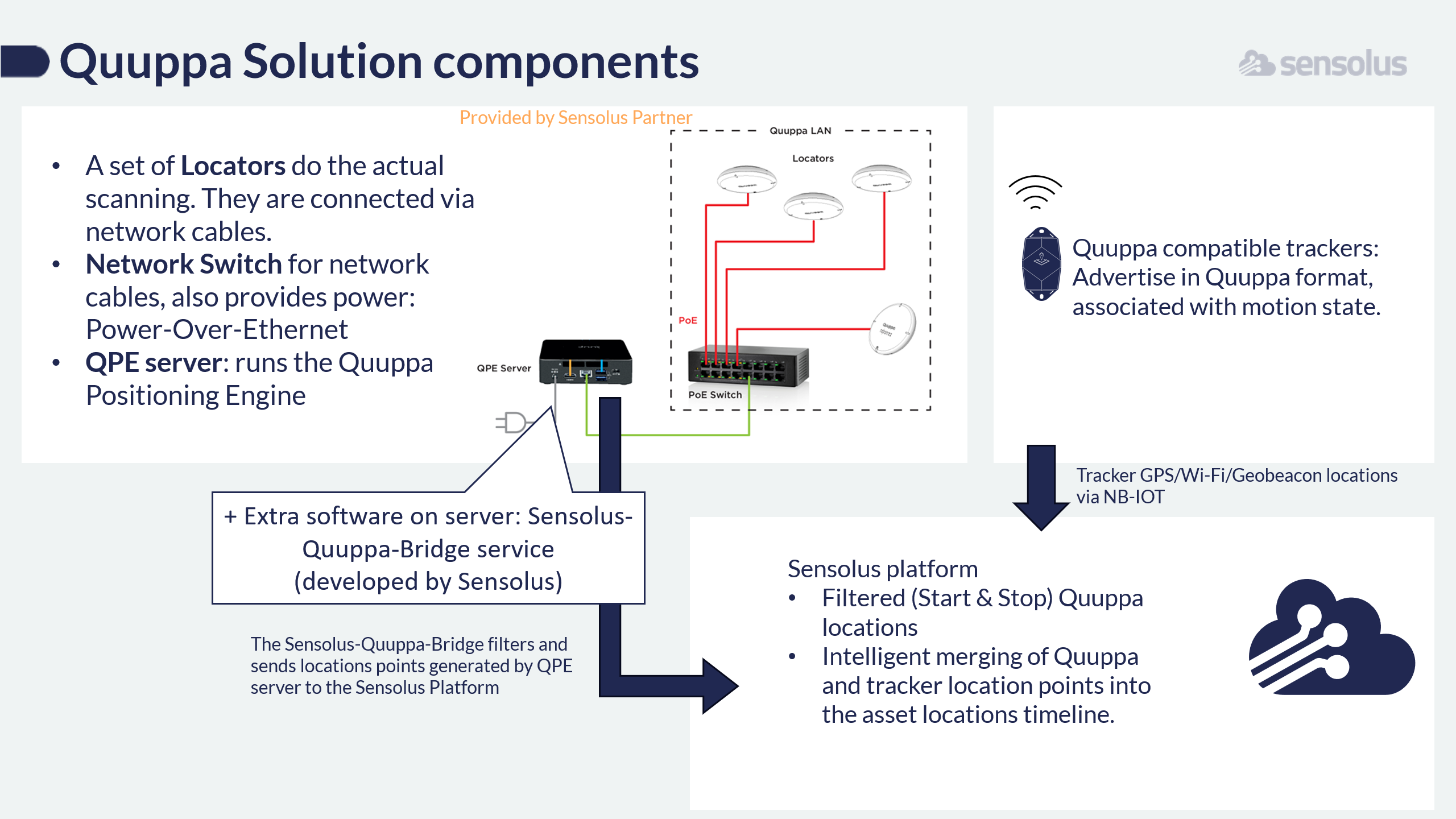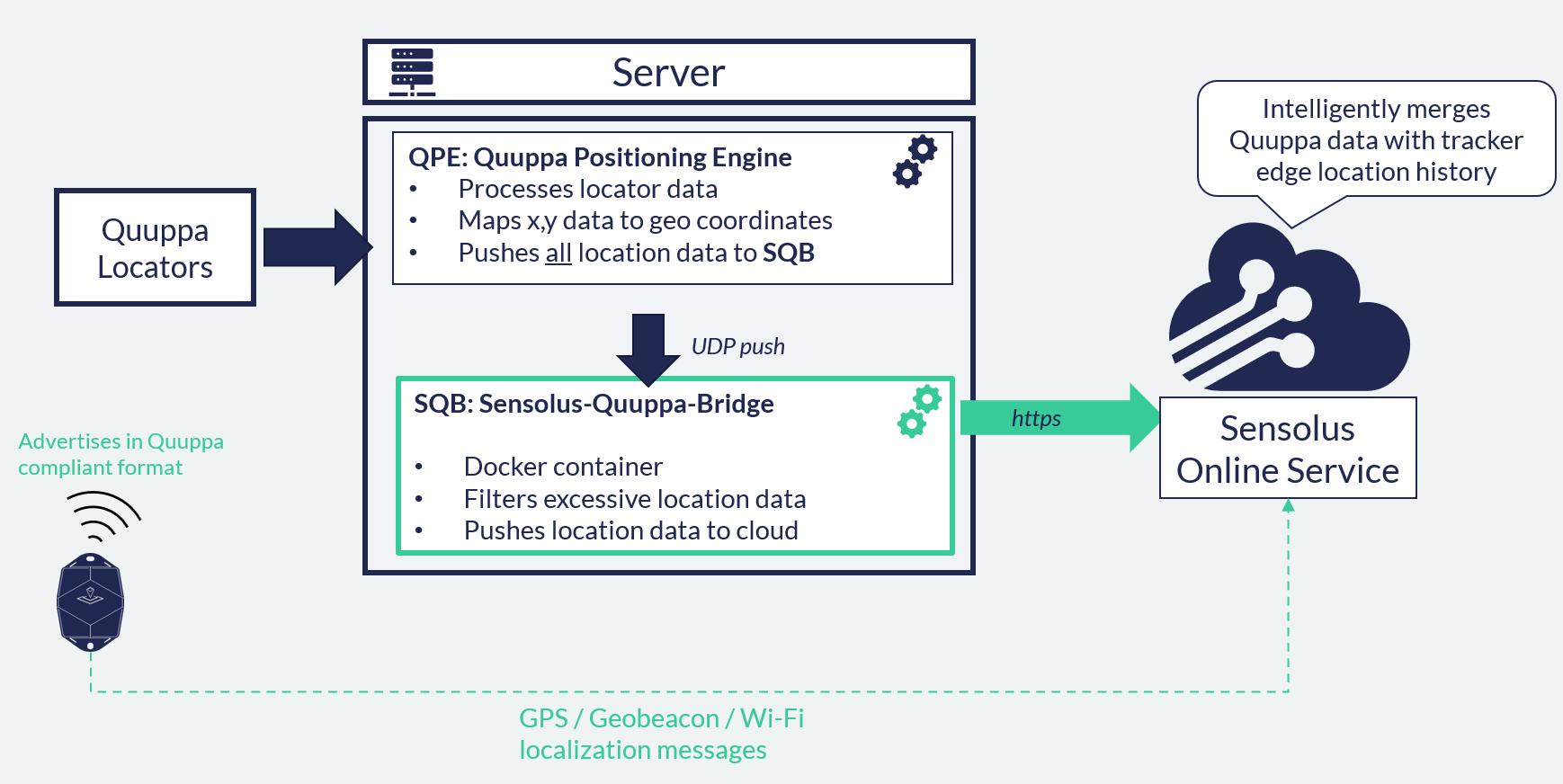Quuppa integration overview
Learn about the components involved in a Sensolus with Quuppa integrated solution.
Sensolus and Quuppa solution components
The different components of a combined Sensolus and Quuppa solution summarized in this diagram:

The actual Quuppa infrastructure deployment is responsibility of the Sensolus partner. This involves:
- The Quuppa Locator devices are the sensors capable of detecting the BLE signals with angle-of-arrival. At this moment, the Quuppa Q35 locator is the product model suitable for industrial environments.
- Network cables are used to connect the locators to a central network switch. PoE (Power-over-ethernet) is used to power the locators,avoiding the need for extra adapters.
- The QPE server is a Linux server that runs the Quuppa Positioning Engine (QPE). Quuppa offers a number of suggested server hardware models, however this can also be different hardware.
The above information on Quuppa components is provided for introduction purposes only and may not be fully up to date. Refer to your partner and/or the Quuppa documentation sources for the latest and accurate information, as well as support or service questions.
The second part of the solution are the components developed by Sensolus:
- The Sensolus-Quuppa-bridge (SQB) software is responsible for conveying the location data from the local QPE server to the Sensolus online platform.
- Sensolus battery powered trackers that are Quuppa compatible, and have the setting enabled. An additional subscription fee per tracker is required to activate Quuppa compatibility.
- The Sensolus online platform processes the incoming data from the SQB as well as the tracker's location messages sent by the tracker itself.
What makes Sensolus trackers Quuppa compatible?
When a tracker is Quuppa enabled, it will emit a Bluetooth signal that is detectable by Quuppa locators.
When indicated on the specifications sheet that Sensolus tracker models are Quuppa compatible, it means that they have been certified by Quuppa as 'Quuppa Tested'. In more detail, how the detectability is optimized:
- Motion detection (with the tracker accelerometer) determines the Quuppa advertisement rate: During motion, Quuppa advertising is done at 3 Hz frequency (to have smoother and more accurate quuppa measurements). When no motion is detected for 20 seconds the advertisements fall back to 0.1 Hz as a battery conserving measure. On the transition from motion to stationary there are 5 extra advertisements at 1 Hz to indicate the state change to the Quuppa infrastructure.
- The tracker motion state (stopped or moving) is also advertised to the Quuppa system; this allows filtering out 'drifting' locations that would otherwise be caused by other objects moving around objects.
- The Quuppa system must be configured to scan in the 'General BLE compatibility mode'. Quuppa also supports tags emitting in their 'proprietary signal mode' (probably this has some advantages, why else would it exist?) but we are not using this on our Sensolus trackers.
Sensolus Quuppa Bridge overview
By default, the bridge software is deployed on the same physical server as the QPE. However it can also be hosted on a different local server for very large deployments with considerable expected load on the server. The SQB receives data from the QPE using the Quuppa UDP Push API. (https://www.quuppa.com/documentation/QPE/topics/QPE_API_methods.html).

In the Sensolus platform, a specific Sensolus Quuppa Bridge instance is represented as an Infrastructure item. The main purpose of this visualization is to verify the online status
Sensolus Quuppa integration in a nutshell:
- Trackers / tags need to be configured to broadcast BLE signals in the specific Quuppa compatible format (this is a different format than the "iBeacon" BLE format).
- Locators are to be installed in the zone of interest. They scan for Quuppa-enabled tags in the surroundings. They are capable of measuring the direction where the tag signals are coming from.
- Locators send their measurements to the Quuppa Positioning Engine (QPE) using network cables. The QPE processes all locator measurements to calculate (trilaterate) the positions of detected devices. The QPE then converts local (x,y) locations coordinates to geo-coordinates.
- QPE is configured that it pushes any changes in location to the Sensolus-Quuppa-Bridge. This is a software service, running on the same server (deployed as a Docker container). Its main task is to send the locations to the Sensolus cloud (using the API to upload). But another, equally important task is to filter out the large number of location updates: the expectation is that only the motion starts and stops are sent to the platform's location history.
- The Sensolus platform applies specific logic to merge the Quuppa locations timeseries of a tracker with the regular localization messages emitted by a tracker. Be aware: the tracker itself is unaware whether or not it is in a Quuppa zone!!! So while in a Quuppa zone, trackers will still do geobeacon/GPS/Wi-Fi … localizations according to the configured localization priority settings. The Sensolus platform ensures that while the tracker is in a Quuppa zone, the Quuppa higher accuracy data is not distorted/interrupted by less accurate Wi-Fi, geobeacon or network locations.
The installation instructions for the SQB are available here: Setup Quuppa integration